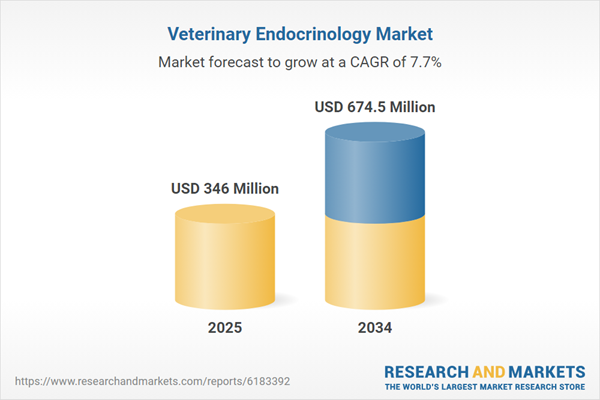Veterinary Endocrinology Market
The veterinary endocrinology market is expanding on the back of longer pet lifespans, rising obesity and sedentary lifestyles, and far better clinical awareness of hormone disorders such as diabetes mellitus, hyperadrenocorticism (Cushing’s disease), hypoadrenocorticism (Addison’s), hypothyroidism, hyperthyroidism in older cats, reproductive/endocrine cycle problems, and calcium/parathyroid imbalances. General practices now screen high-risk animals more routinely - older, obese, PU/PD, dermatology or GI repeat-visits - using in-clinic chemistry, T4/FT4, fructosamine, ACTH stimulation, low-dose dex suppression (LDDS), and urine cortisol:creatinine ratios, while referral and university centers deploy dynamic tests, imaging, and adrenal/thyroid ultrasound to refine diagnoses. Chronic therapy is the commercial engine: long-term insulin therapy and monitoring tools for diabetic dogs and cats, trilostane or mitotane for Cushing’s, levothyroxine for canine hypothyroidism, anti-thyroid drugs or radioiodine referrals for feline hyperthyroidism, plus prescription nutrition to stabilize metabolic status. Pet humanization and insurer coverage make owners more willing to medicate for years, but they expect simple dosing, affordable monitoring, and clear clinical improvement (weight, coat, PU/PD). The competitive landscape includes global animal-health pharma, point-of-care diagnostics companies, practice-management/remote-monitoring platforms, specialty/referral hospitals, and nutrition players with endocrine-support diets. Key challenges remain: variable owner adherence (especially with insulin and timing of meals), need for frequent lab rechecks to fine-tune dosing, cost sensitivity in emerging markets, and uneven access to radioiodine or advanced imaging. As corporate groups push standardized endocrine protocols, suppliers that can bundle drugs, diagnostics, monitoring, and practitioner education will be favored.Veterinary Endocrinology Market Key Insights
- Diabetes is the anchor indication. Stable, veterinary-labeled insulins, pen devices, and clear curves/sheets for at-home glucose monitoring let clinics manage diabetic dogs and cats for years, generating recurring revenue in drugs, strips, and recheck visits.
- Cushing’s drives repeat diagnostics. Trilostane-treated dogs need ACTH stim and clinical scoring to avoid under- or over-control; drugs tied to monitoring protocols create pull-through for in-clinic analyzers and reference labs.
- Thyroid disease is highly visible. Canine hypothyroidism (derm, weight, lethargy) and feline hyperthyroidism (weight loss, vocalization, GI signs) trigger owner concern and fast treatment decisions, supporting levothyroxine, methimazole, transdermal options, and radioiodine referrals.
- Obesity is an endocrine multiplier. Overweight pets show insulin resistance and metabolic stress, so endocrine care is increasingly bundled with weight-management diets and activity plans; nutrition brands are important channel partners.
- POC and tele-endocrine tools gain ground. In-clinic T4, fructosamine, and cortisol tests shorten diagnosis and enhance compliance; remote review of glucose curves or ACTH outputs by internists/cardio-endo specialists helps smaller clinics.
- Owner adherence is the weak link. Twice-daily insulin, timing with meals, and periodic labs can be onerous; apps, auto-reminders, and simplified pens improve persistence and outcomes.
- Geriatric pet boom = more endocrinology. Aging cats and small-breed dogs present with multiple comorbidities (renal, cardiac, dental) that complicate dosing - drugs with good safety margins and clear titration algorithms are preferred.
- Endocrine-dermatology overlap sells tests. Chronic otitis, alopecia, and pyoderma often mask thyroid or adrenal disease; dermatology cases become endocrine cases once screening is normalized.
- Education unlocks non-classic cases. Many Addisonian or atypical Cushing’s animals are missed on first visit; vendor-supplied algorithms, case libraries, and CE help GPs identify and stage more patients.
- Supply reliability and small-pet dosing. Consistent strength, flexible tablet sizes, palatable or compounded options, and clear stability data are procurement gates for large practice groups.
Veterinary Endocrinology Market Reginal Analysis
North America
High pet spend, strong pet-insurance penetration, and mature small-animal practice drive robust uptake of endocrine diagnostics, long-term insulin, trilostane, and thyroid drugs. Corporate hospital groups favor standardized protocols (diabetes, Cushing’s, hypothyroid) and in-clinic analyzers to keep revenue in-house. Remote glucose monitoring and client-education apps are gaining traction.Europe
Advanced companion-animal medicine and strong referral networks support reliable diagnosis and monitoring, but public/insurance cost controls keep pressure on drug pricing and lab frequency. Feline hyperthyroidism management (drug vs radioiodine vs diet) is well established. Traceability, pharmacovigilance, and compounded-drug oversight are important in tenders.Asia-Pacific
Rapid pet humanization in China, Korea, Japan, and Australia is lifting demand for diabetes management, thyroid testing, and endocrine-linked nutrition. Variable insurance coverage and price sensitivity in Southeast Asia lead clinics to offer tiered monitoring plans (POC first, reference-lab second). Growing small-breed, indoor dog populations will increase Cushing’s/hypothyroid caseloads.Middle East & Africa
Urban, expat, and high-income pet owners in major cities seek advanced care for diabetes, thyroid, and adrenal disease, but supply chains and lab access can be inconsistent. Clinics value shelf-stable drugs, easy-to-run POC tests, and remote specialist support. Heat and lifestyle factors raise obesity and diabetes risk, sustaining baseline demand.South & Central America
Expanding middle-class pet ownership and corporate vet chains are creating more consistent endocrine case management. Cost sensitivity limits very frequent lab follow-ups, so practical protocols and affordable insulins/thyroid meds win. Local distributors that ensure drug availability, plus training on diabetes and Cushing’s recognition, are decisive for market development.Veterinary Endocrinology Market Segmentation
By Animal
- Dogs
- Cats
- Others
By Application
- Pancreatic Disorders
- Others
By Route of Administration
- Oral
- Others
Key Market players
Zoetis Inc., Elanco Animal Health Inc., Boehringer Ingelheim Animal Health GmbH, Merck Animal Health (MSD), Dechra Pharmaceuticals plc, Virbac S.A., IDEXX Laboratories Inc., Covetrus Inc., Mars Inc. (Antech Diagnostics), LLOYD Inc., Ceva Santé Animale, Vetoquinol S.A., Hill’s Pet Nutrition (Colgate-Palmolive), Bimeda Animal Health, Heska CorporationVeterinary Endocrinology Market Analytics
The report employs rigorous tools, including Porter’s Five Forces, value chain mapping, and scenario-based modelling, to assess supply-demand dynamics. Cross-sector influences from parent, derived, and substitute markets are evaluated to identify risks and opportunities. Trade and pricing analytics provide an up-to-date view of international flows, including leading exporters, importers, and regional price trends.Macroeconomic indicators, policy frameworks such as carbon pricing and energy security strategies, and evolving consumer behaviour are considered in forecasting scenarios. Recent deal flows, partnerships, and technology innovations are incorporated to assess their impact on future market performance.
Veterinary Endocrinology Market Competitive Intelligence
The competitive landscape is mapped through proprietary frameworks, profiling leading companies with details on business models, product portfolios, financial performance, and strategic initiatives. Key developments such as mergers & acquisitions, technology collaborations, investment inflows, and regional expansions are analyzed for their competitive impact. The report also identifies emerging players and innovative startups contributing to market disruption.Regional insights highlight the most promising investment destinations, regulatory landscapes, and evolving partnerships across energy and industrial corridors.
Countries Covered
- North America - Veterinary Endocrinology market data and outlook to 2034
- United States
- Canada
- Mexico
- Europe - Veterinary Endocrinology market data and outlook to 2034
- Germany
- United Kingdom
- France
- Italy
- Spain
- BeNeLux
- Russia
- Sweden
- Asia-Pacific - Veterinary Endocrinology market data and outlook to 2034
- China
- Japan
- India
- South Korea
- Australia
- Indonesia
- Malaysia
- Vietnam
- Middle East and Africa - Veterinary Endocrinology market data and outlook to 2034
- Saudi Arabia
- South Africa
- Iran
- UAE
- Egypt
- South and Central America - Veterinary Endocrinology market data and outlook to 2034
- Brazil
- Argentina
- Chile
- Peru
Research Methodology
This study combines primary inputs from industry experts across the Veterinary Endocrinology value chain with secondary data from associations, government publications, trade databases, and company disclosures. Proprietary modeling techniques, including data triangulation, statistical correlation, and scenario planning, are applied to deliver reliable market sizing and forecasting.Key Questions Addressed
- What is the current and forecast market size of the Veterinary Endocrinology industry at global, regional, and country levels?
- Which types, applications, and technologies present the highest growth potential?
- How are supply chains adapting to geopolitical and economic shocks?
- What role do policy frameworks, trade flows, and sustainability targets play in shaping demand?
- Who are the leading players, and how are their strategies evolving in the face of global uncertainty?
- Which regional “hotspots” and customer segments will outpace the market, and what go-to-market and partnership models best support entry and expansion?
- Where are the most investable opportunities - across technology roadmaps, sustainability-linked innovation, and M&A - and what is the best segment to invest over the next 3-5 years?
Your Key Takeaways from the Veterinary Endocrinology Market Report
- Global Veterinary Endocrinology market size and growth projections (CAGR), 2024-2034
- Impact of Russia-Ukraine, Israel-Palestine, and Hamas conflicts on Veterinary Endocrinology trade, costs, and supply chains
- Veterinary Endocrinology market size, share, and outlook across 5 regions and 27 countries, 2023-2034
- Veterinary Endocrinology market size, CAGR, and market share of key products, applications, and end-user verticals, 2023-2034
- Short- and long-term Veterinary Endocrinology market trends, drivers, restraints, and opportunities
- Porter’s Five Forces analysis, technological developments, and Veterinary Endocrinology supply chain analysis
- Veterinary Endocrinology trade analysis, Veterinary Endocrinology market price analysis, and Veterinary Endocrinology supply/demand dynamics
- Profiles of 5 leading companies - overview, key strategies, financials, and products
- Latest Veterinary Endocrinology market news and developments
Additional Support
With the purchase of this report, you will receive:- An updated PDF report and an MS Excel data workbook containing all market tables and figures for easy analysis.
- 7-day post-sale analyst support for clarifications and in-scope supplementary data, ensuring the deliverable aligns precisely with your requirements.
- Complimentary report update to incorporate the latest available data and the impact of recent market developments.
This product will be delivered within 1-3 business days.
Table of Contents
Companies Mentioned
- Zoetis Inc.
- Elanco Animal Health Inc.
- Boehringer Ingelheim Animal Health GmbH
- Merck Animal Health (MSD)
- Dechra Pharmaceuticals PLC
- Virbac S.A.
- IDEXX Laboratories Inc.
- Covetrus Inc.
- Mars Inc. (Antech Diagnostics)
- LLOYD Inc.
- Ceva Santé Animale
- Vetoquinol S.A.
- Hill’s Pet Nutrition (Colgate-Palmolive)
- Bimeda Animal Health
- Heska Corporation
Table Information
| Report Attribute | Details |
|---|---|
| No. of Pages | 160 |
| Published | November 2025 |
| Forecast Period | 2025 - 2034 |
| Estimated Market Value ( USD | $ 346 Million |
| Forecasted Market Value ( USD | $ 674.5 Million |
| Compound Annual Growth Rate | 7.7% |
| Regions Covered | Global |
| No. of Companies Mentioned | 15 |









